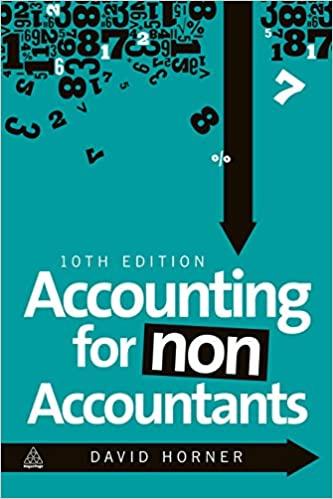Question
Lehighton Chalk Company manufactures sidewalk chalk, which it sells online by the box at $25 per unit. Lehighton uses an actual costing system, which means
Lehighton Chalk Company manufactures sidewalk chalk, which it sells online by the box at $25 per unit. Lehighton uses an actual costing system, which means that the actual costs of direct material, direct labor, and manufacturing overhead are entered into work-in-process inventory. The actual application rate for manufacturing overhead is computed each year; actual manufacturing overhead is divided by actual production (in units) to compute the application rate. Information for Lehightons first two years of operation is as follows:
| Year 1 | Year 2 | ||||||
| Sales (in units) | 2,500 | 2,500 | |||||
| Production (in units) | 3,100 | 1,900 | |||||
| Production costs: | |||||||
| Variable manufacturing costs | $ | 15,190 | $ | 9,310 | |||
| Fixed manufacturing overhead | 18,290 | 18,290 | |||||
| Selling and administrative costs: | |||||||
| Variable | 10,000 | 10,000 | |||||
| Fixed | 9,000 | 9,000 | |||||
Selected information from Lehightons year-end balance sheets for its first two years of operation is as follows:
| LEHIGHTON CHALK COMPANY | ||||||
| Selected Balance Sheet Information | ||||||
| Based on absorption costing | End of Year 1 | End of Year 2 | ||||
| Finished-goods inventory | $ | 6,480 | $ | 0 | ||
| Retained earnings | 11,000 | 17,720 | ||||
| Based on variable costing | End of Year 1 | End of Year 2 | ||||
| Finished-goods inventory | $ | 2,940 | $ | 0 | ||
| Retained earnings | 7,460 | 17,720 | ||||
Required: 4. Compute the amount by which the year-end balance in finished-goods inventory declined during year 2 (i.e., between December 31 of year 1 and December 31 of year 2):
- Using the data from the balance sheet prepared under absorption costing.
- Using the data from the balance sheet prepared under variable costing.
5. Refer to your calculations from requirement 4. Compute the difference in the amount by which the year-end balances in finished-goods inventory declined under absorption versus variable costing. Then compare the amount of this difference with the difference in the companys reported operating income for year 2 under absorption versus variable costing.


Step by Step Solution
There are 3 Steps involved in it
Step: 1

Get Instant Access to Expert-Tailored Solutions
See step-by-step solutions with expert insights and AI powered tools for academic success
Step: 2

Step: 3

Ace Your Homework with AI
Get the answers you need in no time with our AI-driven, step-by-step assistance
Get Started


